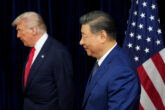November 21, 2019
Decide, Disrupt, Destroy: Information Systems in Great Power Competition with China
The 2018 US National Defense Strategy (NDS) cites Russia and the People’s Republic of China (PRC) as “revisionist powers” that “want to shape a world consistent with their authoritarian model— gaining veto authority over other nations’ economic, diplomatic, and security decisions.”1 It describes these countries as competitors seeking to use “other areas of competition short of open warfare to achieve their [authoritarian] ends” and to “optimize their targeting of our battle networks and operational concepts.”2 The NDS assesses that competition will occur along the entire spectrum of statecraft from peace to open conflict and that Russia and the PRC will align their foreign policies with their models of governance. If this assessment is correct, and if technology plays a significant role in international politics, then technology will affect the whole spectrum of great power competition and conflict. Information architecture—the structures of technology that collect and relay information worldwide—is innately connected to power projection. The PRC has been innovating in this area, and its expanded information capabilities—and risks to US capabilities—will shape competition in the twenty-first century. Likewise, this competition will influence how the PRC develops and uses communications technologies before, during, and after the threshold of a potential conflict.
The PRC has, in its short 70 years of history, matured from a fledgling postrevolutionary state to an impressive near-peer competitor with a global vision for foreign policy. Xi Jinping has touted a “community of common destiny” as the PRC’s foreign policy vision.3 This concept predates Xi, as do many other Chinese Communist Party (CCP) concepts. While leadership personalities change, the PRC has demonstrated a great deal of continuity in its approach to foreign policy, including an emphasis on strategic information support, information operations, and shaping adversaries’ actions below the threshold of open conflict. Even as the PRC grows in its ambitions and capabilities, these concepts can inform an understanding of its activities and the ways it seeks to accomplish its objectives.
Read the full article in Strategic Studies Quarterly.
- Department of Defense, Summary of the 2018 National Defense Strategy of the United States of America (Washington, DC: Department of Defense, 2018), 2, https://dod.defense.gov/Portals/1/Documents/pubs/2018-National-Defense-Strategy-Summary.pdf. ↩
- Department of Defense, 3. ↩
- Liza Tobin, “Xi’s Vision for Transforming Global Governance: A Strategic Challenge for Washington and Its Allies,” Texas National Security Review 2, no. 1 (November 2018), https://tnsr.org/. ↩
More from CNAS
-
Transatlantic Security / Technology & National Security
Look Before We Leap on Artificial IntelligenceThis article was originally published on The Dispatch. A debate about the role that artificial intelligence should and will play in society, and how it will affect humanity fo...
By Jon B. Wolfsthal
-
Technology & National Security
Caleb Withers on the Cybersecurity Frontier in the Age of AICaleb Withers, research associate at the Center for a New American Security, joins Kevin Frazier, the AI Innovation and Law Fellow at the University of Texas School of Law and...
By Caleb Withers
-
Technology & National Security
Prepared, Not ParalyzedExecutive Summary The Trump administration has embraced a pro-innovation approach to artificial intelligence (AI) policy. Its AI Action Plan, released July 2025, underscores t...
By Janet Egan, Spencer Michaels & Caleb Withers
-
Indo-Pacific Security / Technology & National Security
Sharper: Tech + ChinaRecent talks between President Donald Trump and Chinese Communist Party General Secretary Xi Jinping placed a spotlight on emerging technologies, from high-end chips to minera...
By Charles Horn & Sevi Silvia




